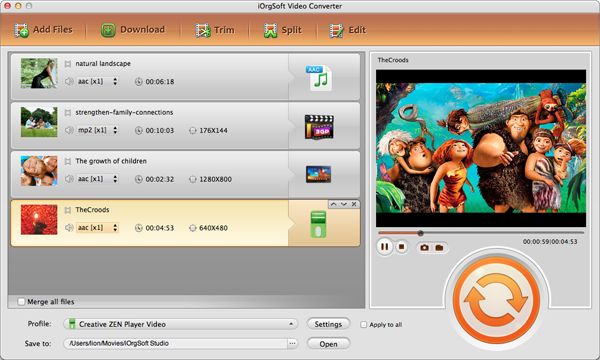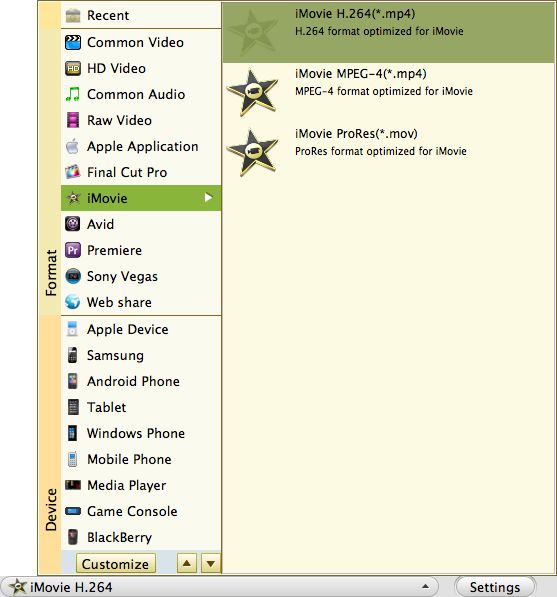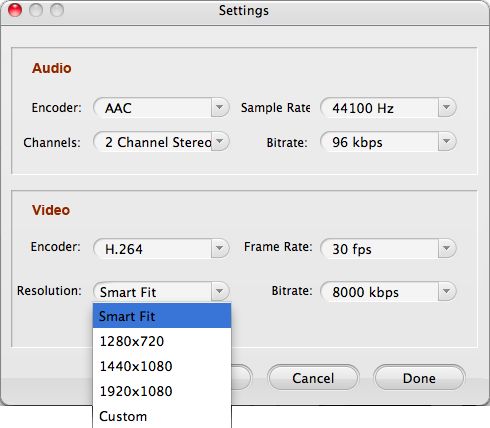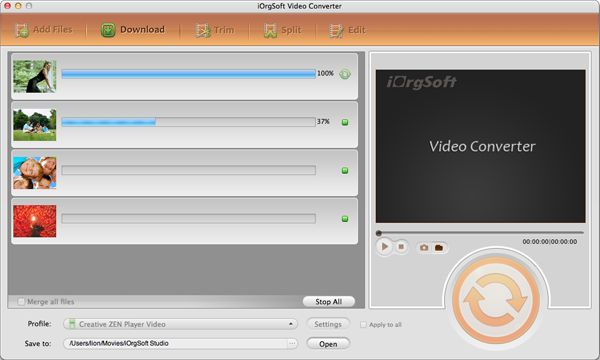

Apple iMovie is a proprietary application for editing videos for the Macintosh, and handheld devices that use iOS; iPhone, iPod Touch, iPad, and iPad mini. In 1999, the first-ever Macintosh model that had a FireWire, the iMac DV, came with the first version of iMovie. This changed after the 3 version was released and only devices with the OS X operating system could use the software, which was bundled with the iLife suite for Macintosh. Apple iMovie can use the FireWire or USB ports to import video footage from recording devices and can also import photos and videos from an external hard drive. Once imported, all the footage can be brought together and edited to make a high quality production; effects, music and the adding of titles is easily managed when using iMovie. But iMovie is not perfect. It has limit on support of video format.
Part 1: iMovie Supported and Unsupported Video Formats
Part 3: How to Import Video Formats NOT Supported by iMovie
|
Video Format |
Abbreviation |
Brief Description |
|---|---|---|
Motion Picture Experts Group 4 |
.MPEG4 .MP4 |
This is a method in which Audio and Video digital media can be stored; Photos and titles are also supported. The compression ratio is very high, and is suitable for videos that need to retain their high definition, but have a small size. |
Motion Picture Experts Group 2 |
.MPEG2 | The International Telecommunications Union (ITU) also defines this as the H.222/H.262. This is a generic coding method, which allows or easy transmission and passing of video and audio data, using existing media and bandwidth. The quality is not as high as later versions, but it is backward compatible and is therefore preferred for DVD production. |
Advanced Video Coding High Definition |
AVCHD | This is a format that is used for High Definition video; it uses the MPEG-4 AVC/H.264 standard to compress video without losing quality. It was first used by Sony and Panasonic in their Digital Camcorders. |
QuickTime Movie |
.MOV | This is actually a file container that has several tracks on which you can place video, audio, text and effects. The tracks can either contain the files, or they can have references to where the files are located externally. |
Digital Video |
DV | This is a format that was developed for Video Cameras. The video is stored as lossy footage while the audio is not compressed at all. |
High-Definition Video |
HDV 720p HDV 1080i |
This was a format that could store high-definition video on a DV cassette, and was originally used by JVC and SONY for their cameras. HDV is easy to import and still maintains the high quality of images in the video. |
Motion Joint Photographic Experts Group |
M-JPEG MJPEG |
This is a video format where each frame is compressed as a separate JPEG image; this also applies to an interlaced partition of DV. |
Table 1: Video formats that are supported by Apple iMovie.
The formats that will not be accepted into iMovie and require conversion are those that are usually those compatible with the Windows Operating System.
|
Video Format |
Abbreviation |
Brief Description |
|---|---|---|
Windows Media Video |
.WMV |
Although initially developed for video creation and viewing on the Windows operating system, the WMV 9 was adopted, after standardization by the Society of Motion Picture and Television Engineers (SMPTE) for use in HD DVD and Blu-Ray Discs. |
Audio Video Interleaved |
.AVI | This is another video format that was developed specifically for Windows. The files contain Video and Audio data in a container allowing for synchronized AV playback. |
Adobe Flash |
.SWF | This is the original format for all flash video, and contained applets and animations which offered a certain degree of interactivity. These files are commonly used to deliver animated GIFs, mainly for websites and also online games. |
Flash Video |
.FLV .F4V |
This is a container through which one can deliver video using Adobe Flash Player. FLV has the same coding as SWF files, but the F4V is built on the ISO base media file format. |
Matroska Video |
.MKV | This is a container developed by Matroska Multimedia Company. One of the reasons why this container is so popular is the fact that it can hold an unlimited number of audio, video, picture and title tracks in one file, making it a convenient mode of delivering AV content. |
Table 2: Video formats that are not supported by Apple iMovie.
In fact, besides those listed on Table 2, there are formats that have been listed in Table 1 that bring about import difficulties when being imported into Apple iMovie. The main reason behind this is because they have been compressed using codecs that are designed for Windows. However, there are video files that are compressed using codecs that are compatible with the Macintosh, but they still cannot be imported into iMovie. You will find this occurring when you use video that is being delivered through containers, such as .MOV and .MP4. The MP4 container works only when the files are encoded using MPEG4/AAC and H.264/AAC data, where AAC stands for Advanced Audio Coding Codec. The other file in this category that is easily compatible with iMovie is the M4V and you should store files as M4V instead of MP4 in order to avoid the compatibility issues.
Another format that is popular with most camcorders, and has issues when being imported into iMovie, is AVCHD; both MTS and M2TS. The reason for this is the fact that the camcorder did not send the full AVCHD structure and iMovie refuses to recognize the whole file. The best way to go around this is to wrap the MTS files using the Apple Intermediate Codec (AIC), which is bundled in most video converters for the Macintosh.
Generally, when you have support difficulties when you are importing video to Apple iMovie, you have to use a video converter so that you can change the codecs to those compatible with Macintosh, so you can easily import the video into iMovie.
The two most common export formats for iMovie are MPEG4 and QuickTime, the descriptions of which can be found in table 1 above. The other formats are for playback on specific devices and these are as follows:
1) Apple TV – This is an export format that is specifically targeted at the Apple TV device; The device is used as a console that can collect data from several sources and stream them to a High-Definition Multimedia Interface (HDMI) TV.
2) FLIC – This is also known as .FLC or .FLI. This format is mainly used for animation files and was originally developed by Autodesk for video produced using their animation packages.
3) Image Sequence – All the frames in the video are exported as separate still images.
4) iPhone and iPod – In this case, the video is exported for playback on these particular devices.
How to get the formats NOT supported by iMovie imported and editable into iMovie then? Following are the methods we recommend to you.
One of the best methods is to use the iOrgSoft Video Editor for Mac to convert those formats to iMovie compatible one. This is a video converter that offers comprehensive tools for Macintosh users to convert video into formats that are compatible with the Mac, and also the editing software produced by Apple; iMovie is one of the applications which require some video formats to be converted into compatible formats. It is fantastic to use since it has an insignificant loss in quality, and everything can be done at the click of a button; you get video compatible with editing suites that have their own native formats, such as AVID, FCP and, of course, Apple iMovie.
Secure Download
Secure Download
Here are the steps to follow when using the iOrgsoft Video Converter for Mac.
1. Import the video into the converter - Click on the Add File button, and then browse for the files you want to import. You can also drag the video from the explorer to the program directly.

2. Set the output format and destination where you want to save the video - After importing the video, a small icon will be displayed next to the file, and you have to click on it to choose the desired output format. After this, use the "save to" button to choose the output destination.

3. Go to the "Setting" tab and tweak the settings and parameters of the output video that you want.

4. The final step is to convert the video; simply press the big button on the screen. You will see the status of the conversion and when complete, the folder where the output video has been stored will be opened.

At other times, it is not the movie format that brings about the problem, but the hardware that is being used. At times, you will find that a computer may require that the source device be connected at all times for any editing to be done on iMovie. There are files that require a lot of resources when editing, and you cannot import them all into iMovie; this necessitates you to edit the video while the camcorder is still connected to the computer. This is a slow and tedious method process. To solve this, you should try to transfer the video in raw format into the computer, such as on the desktop, and then import it into iMovie.




Terms & Conditions| Privacy| Sitemap| Contact Us| About Us| Affiliate| Newsletter| License Agreement| Uninstall
Browser compatibility : IE/Firefox/Chrome/Opera/Safari/Maxthon/Netscape
Copyright © 2007-2016 iOrgsoft Studio All Rights Reserved